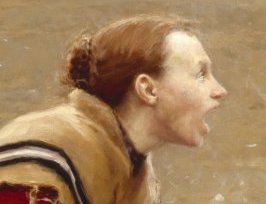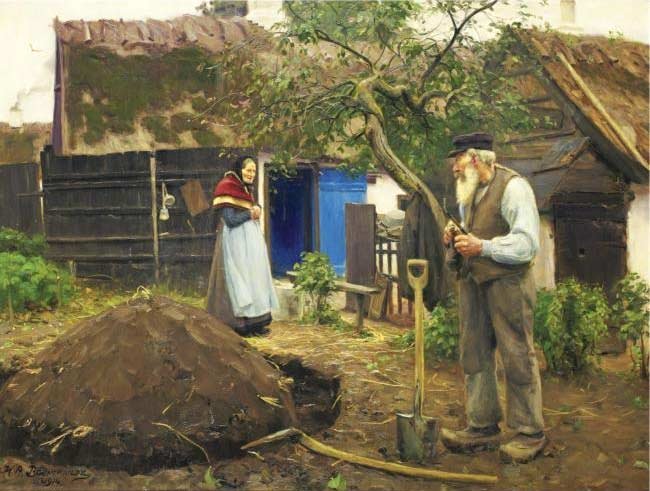
As I have said before, I choose the subject for my blogs based on having sufficient information about the artist and also access to a large selection of his or her work. Without those two criteria the blog would be somewhat empty. I also prefer to feature “unknown” (at least, to me) artists. However, once in a while, there comes a time when I look at a painting and have the overwhelming desire to share it with you, even before knowing whether my two criteria could be achieved. Today’s blog is one of those occasions.
My featured artist today is the nineteenth Danish painter Hans Andersen Brendekilde although at birth his name was simply Hans Andersen but later added to his surname the name of his birth village, Brændekilde. He was born on April 7th, 1857, on the island of Funen, the third largest Danish island,which lies five miles south-west of the island’s main town, Odense. He was brought up in an impoverished household and had to try and support the family by doing jobs, which included working in the house of a farmer doing chores. His father, Anders Rasmussen, was a maker of wooden shoes and his mother was Maren Nielsdatter.

As a child, Hans was interested in carving figures of animals out of wood. When he was attending the local school one of his teachers discovered his talent as an artist and sent him to a school in Odense. Here he became a good friend of Axel Blumensaadt, and it was Axel’s mother who helped fund Hans to attend the Academy of Fine Arts in Copenhagen, where he initially studied sculpture.

He became a friend and associate of painter Laurits Andersen, and in 1881 he left behind sculpting to take up painting. Laurits Andersen and Hans Andersen held a joint exhibition, but because of the confusion of their surnames they both decided to add their birthplace to their name and so Laurits who was born in the Zeeland village of Ring became known as Laurits Andersen Ring (L.A. Ring) and Hans took the name Hans Andersen Brendekilde (H.A. Brendekilde). Their paintings at their first exhibition now had their “new” designated surnames to avoid confusion.
In the summer of 1882 Hans and some other artists were invited to stay on a farm in Rugelund by its owner and soon an artist colony was formed. For Hans it was not just a chance to paint and mix with fellow artists it was a chance to be well-fed. It was also a chance to see first-hand the harsh working environment of the rural workers which he would later depict on many of his canvases. But all was not doom and gloom in his works for often, in comparison to his gritty social realism works, other paintings by Brendekilde highlighted the pleasures of living in the countryside.

But let us have a look at probably his most famous work, the one which drew me to looking into his life. It was his social realist painting entitled Udslidt (Worn Out) which he completed in 1889.
In this heart-rending depiction we see a day-labourer lying crumpled on the rock-strewn ground of the barren field where he had been working. His onerous task, with other peasants, would have been to remove the stones from the ground, prior to ploughing and planting, and put them in piles awaiting disposal. The field although barren takes up eighty per cent of the picture. Look at the detail Brendekilde has incorporated in his depiction of the ground. However, what is more emotive is the portrayal of the two figures in the foreground. The elderly peasant worker has stumbled and fallen to the ground. He is dressed in shabby clothes which are covered in dirt. One of his wooden clogs has fallen off during his fall. The heavy stones he had been carry in his apron, lie on the ground next to him. He had finally been overcome by exhaustion or maybe he has suffered a heart attack. A woman, maybe his wife or daughter or just a co-worker, has rushed to his aid. She is kneeling next to him and cradles his head.

Her mouth is open wide as she screams for somebody to come and help. Her impassioned plea has yet to be answered and she is both overwhelmed with fear for the man and her own helplessness. The picture was exhibited at the Exposition Universelle of 1889 and also at The World’s Columbian Exposition in Chicago in 1893.
It received a mixed reception. Many people lavished praise on the artist for the work whilst the “monied-people” and the bourgeois press thought the painting was over-melodramatic and condemned it for its blatant political stance about the life of the poor and downtrodden which they obviously didn’t want to be reminded about.

Another of his works with a depiction in a similar vain is his 1887 painting simply entitled Fortrykt which literally translated now means “pre-printed” but it is more likely that the artist was using the word to mean “supressed” or “subdued”. The painting was completed two years before the previous work Worn Out and again dwells on the hardship suffered by the rural peasant class, who were the social losers and who were way down the social ladder. Four people dominate the foreground and we may surmise that they are a young woman and her child along with her mother or older sister and her father. The older woman and the seated father are dressed in old clothes and have been working in the fields gathering bits of grain to take home.

They are the gleaners, as depicted in Millet’s famous 1857 painting, The Gleaners. Gleaning is the act of collecting leftover crops from farmers’ fields after they have been commercially harvested or on fields where it is not economically profitable to harvest. It is the Biblically-derived right to glean the fields and was reserved for the poor; a right, enforceable by law, that continued in parts of Europe into modern times. The young woman is dressed in finer clothes and has not been working in the field. She is talking to her father and her mother raises her head to listen. The father sits on a bag of grain and looks exhausted and yet there seems to be an air of resignation about him. He has accepted his lowly lot in life. Has his daughter told him something he didn’t want to hear? Is it something to do with young child who, whilst amusing herself, is sitting on a pile of coats?

At the end of the nineteenth century Brendekilde painted several cutting social-realist works. At other times he depicted the everyday life of poor people without critical undertones. These were more to do with the happier memories Brendekilde had of rural life when lack of money could not detract from the pleasures of immersing oneself in nature such as his 1889 springtime painting, The First Anemones.

Again, we see a similar setting in his work A Spring Day when the villagers, dressed in their “Sunday-best” clothes take a pleasurable walk through the forest.

Another fascinating and evocative work is his 1908 oil painting, Autumn. It is a combination of a landscape and sombre realist style painting in which we see an elderly lady standing by an open grave in a cemetery. It is a dark autumn day and we see the leaves from the nearby trees lying all around. There is a gale blowing which is stripping the leaves from the trees which are leaning over due to the ferocity of the wind. In the middle ground one can see the church and the green grass of the graveyard. Two black crosses have been blown over and lie abandoned against a hillock. Some graves seem to have been tended whilst others look abandoned. The old woman through her age and the strength of the wind is bent over and she clutches at her dress whilst holding on to her walking cane. She gazes into the excavated hole in the ground. The question the artist poses is what are her thoughts. Has she lost a loved one who will be buried in this plot or is she contemplating her own end of life. Could this even be termed a vanitas painting? One of the pleasures of looking at a painting is to try and decide for ourselves what we see in a depiction and work out what the artist was trying to convey.

The autumn season often featured in Brendekilde’s painting. He enjoyed depicting this colourful time of the year. A time when the normally green leaves of many deciduous trees and shrubs slowly turn to various shades of red, yellow, purple, black, orange, pink, magenta, blue and brown, during a few weeks in the autumn season, before they fall to the ground. Brendekilde beautifully captures that moment in his 1902 painting entitled A Wooded Path in Autumn.

Elderly people often featured in Brendekilde’s paintings and another of my favourites is his painting entitled A Short Respite in which we see an old man taking a rest from his gardening chores looked on by his wife.

It was not just the elderly who featured in Brendekilde’s works of art, nor were the subjects of his painting always sombre. In later life, he would concentrate on idyllic village scenes often depicting happy children, innocent children, and these proved very popular with the public.

In many of his paintings featuring children he also included one or two elderly people. Maybe he remembered his childhood days and how elderly relatives and neighbours played a part in his life. It seems strange now that some look upon paintings depicting an older person with a child as something suspicious and unnatural. Gone are the days when we accept unconditionally that our young children and an elderly person such as a relative can form a bond and in some ways learn from each other.

Brendekilde died on 30 March 1942, aged 84, in Jyllinge, a town located on the eastern shores of Roskilde Fjord, some 40 km west of Copenhagen.

Thank you, so interesting ànd well researched.
I can understand why some people thought that Udslidt (Worn Out) was over-melodramatic. While it looks a bit staged, or maybe like a movie still, nevertheless it is a very touching image. I think it is one of those social realist paintings that stays ingrained in your visual memory for a long time.
Hello Blogger, I love the work you’ve done here. I wanted to ask if you if you have any resources saved from your research into Brendekilde and his “Udslidt.” I am an art student and am doing some research into “Udslidt” and am having a hard time finding resources in English, besides your own. Thank you for time